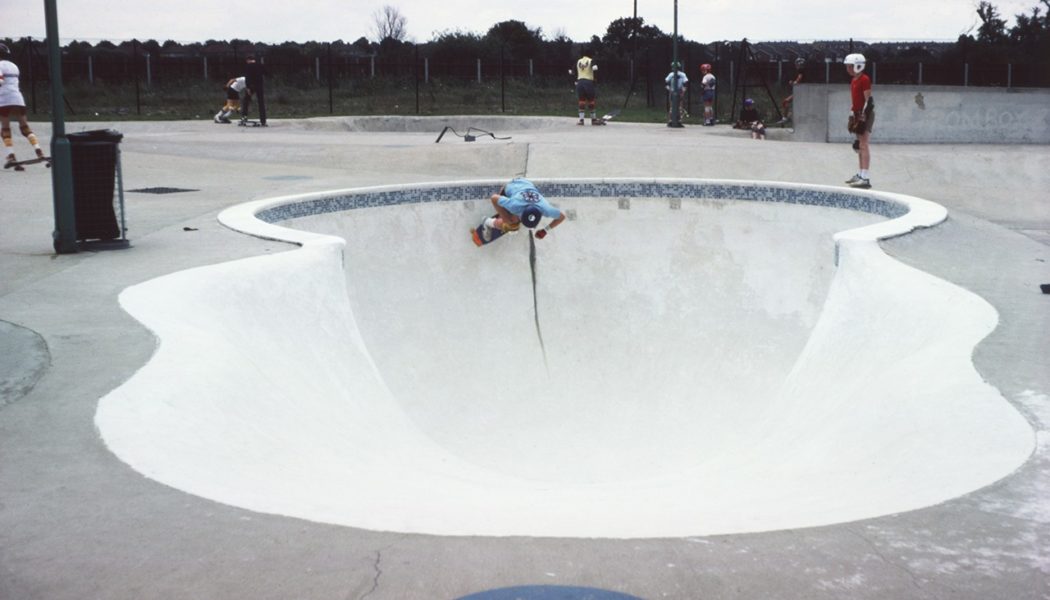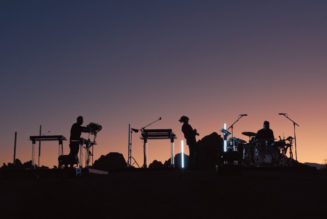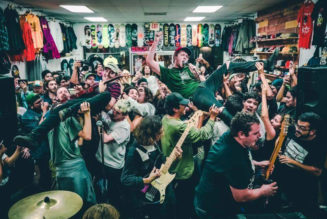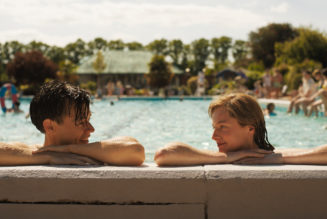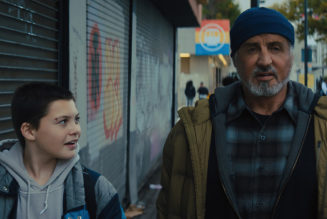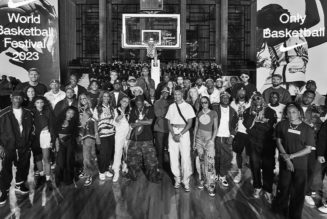When the history of skateboarding is told, the influence of the U.S. is everywhere. From the early days documented in Dogtown and Z-Boys — and the much-told story of California’s long, hot summers — to how Supreme conquered the world from Lafayette Street, skateboarding is predominantly documented as an American activity.
Away from the States, however, skateboarding has formed subcultures and communities in countries worldwide — and arguably nowhere more so than across the Atlantic in the U.K. After skating became more widespread in Britain in the late ‘70s, the scene has gone through peaks and troughs, as it rose and fell in popularity and cultural capital. But British skating has become a foundational part of the culture, from Liverpool-born Geoff Rowley winning Thrasher’s Skater of the Year to the Southbank’s international renown as a community hub, and the global dominance of British skate brands like Palace.
This year, skateboarding’s expansion continues. Whatever people think of its controversial inclusion in the Olympics, it will soon be visible to more people around the world than ever before. Alongside skateboarding’s first Olympic event, London’s Somerset House has opened the doors to No Comply: Skate Culture and Community, charting its impact on the U.K. over the last 50 years.
Marking both of these occasions, HYPEBEAST has spoken with the people who have been involved with skateboarding in Britain for the last five decades. Whether professional skaters, photographers or historians, each of them saw the British skateboarding scene evolve around them, and played their own role in shaping the culture as we know it.
In part one of our oral history of British skateboarding, we look at how an initial booom receded into obscurity within five years, before a more transgressive and raw form took hold, paving the way for skateboarding today.
“When I started skateboarding in 1977, you didn’t tell your mates that you went skateboarding, it wasn’t cool.”
The Early Years
Iain Borden, historian and author of Skateboarding, Space and the City: When skateboarding first came to Britain in the 1960s, it was heavily associated with surfing. It was often called “sidewalk surfing,” and Cathay News described it as an Australian activity. They saw it as an Australian import.
Tory Turk, curator of No Comply: Originally, skateboarding was seen as a kiddy sport, a bit of a fad. Pretty much every kid in the late ‘70s got a skateboard, or a book about skateboarding as a Christmas present
Borden: When it boomed again in ‘76/77, it was seen as a kids activity, and a slightly nerdy one. When I started skateboarding in 1977, you didn’t tell your mates that you went skateboarding, it wasn’t cool — it was for the kids who maybe weren’t so good at other sports. It was seen as what the slightly outsider kids would do, and it was definitely seen as a child’s activity. Anyone in their 20s was ancient at that point.
Turk: In the late ‘70s, a lot of skate parks popped up and people really embraced it. Most of them had closed by 1980 anyway.
Borden: A series of skate parks were built in the late 1970s in the UK, but they didn’t last very long. Most of them were commercial, and they financially didn’t work.
Dan Adams, RaD Archive: Anybody that was involved in skateboarding as a kid in the late ‘70s and early ‘80s really got all their information from a couple of magazines from America — initially Skateboarder, which was an amazing magazine that was distributed all over the world. It was the voice piece for skateboarding and it was the only way you could work out how it was actually evolving and who the people were. There was no TV, no video, no nothing.
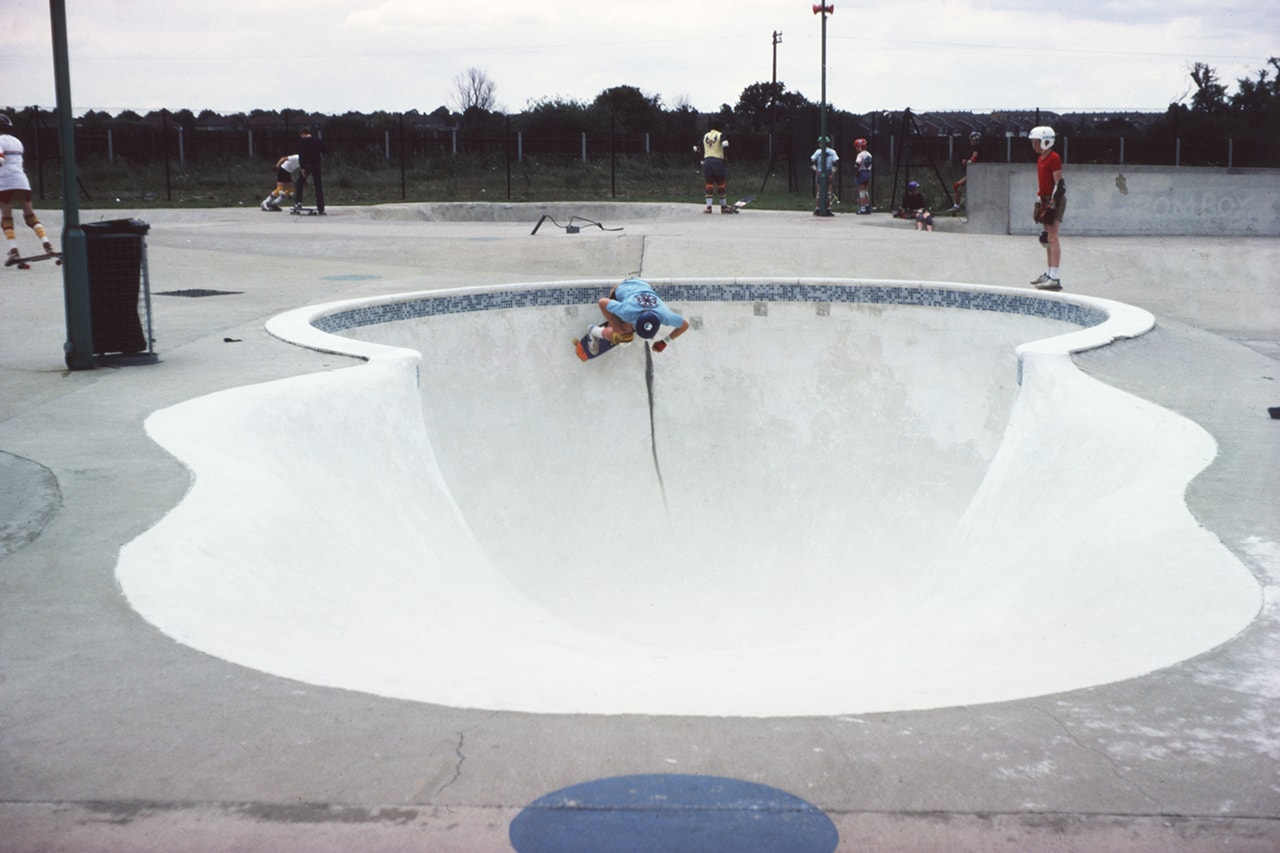
Iain Borden
The First Dip
Mark “Trawler” Lawer, author of 8ft Tranny and a Foot of Vert: I think it all exploded too quickly. The parks were not well-made. In many cases businessmen got carried away with the new money making scheme that they thought would make them a fortune. The insurance for parks skyrocketed out of control because people were getting hurt, and different ways of controlling the kids had to be put in place, like marshalling schemes and skill level badge systems so you couldn’t fly into the deepest bowl on day one. Eventually, though, red tape got the better of these places and they had to close.
If you’d been going to a skate park since you were a kid it was part of your makeup, the way you made friends and the people you hung out with were at the skatepark. When the skateparks closed it was like the rug was pulled from under you.
Winstan Whitter, filmmaker and director of Rollin’ Through the Decades: Southbank had always been the heartbeat of skateboarding in England, even before the boom in the ‘70s. When the boom died out, not a lot of people skated Southbank, but some people still went there. People from different parts of the country still had a skateboard, and they were thinking skateboarding had died, but maybe they could go to Southbank and see if there were any other skaters. People would travel down and find other skaters, they’d meet up and make friends.
Trawler: After the initial craze of skateboarding, all that was left with the hardcore people that loved it to death — and it was almost to death. The early magazines declared that skateboarding was dead but some of us carried on. The parks were closed, and we were left to fend for ourselves. Those that didn’t want to quit and still had the fire in them wanted to keep skating via ramps as a replacement to the skate parks.
After figuring it out from a few ramp plans that were published in Thrasher magazine and other places we started collecting wood and making our own ramps, or we’d use some metal ramp frames from the closed skate parks. We learnt quickly.
“Skateboarding felt like a very marginal place to be in the 1980s. The ‘70s boom had come and gone and made skateboarding look like just another craze.”
Wig Worland, photographer and co-founder of Sidewalk Magazine: Skateboarding felt like a very marginal place to be in the 1980s. The ‘70s boom had come and gone and made skateboarding look like just another craze but skateboarding came back in a more edgy way in the 1980s.
Adams: A lot of the magazines all stopped publishing, and the skate parks started to close because they weren’t commercially viable, and you felt if you were still skateboarding, then you were part of some really secret society. When you’re young and impressionable, that’s a very powerful experience to feel like you’re involved in something special.
Worland: Back then, skaters were seen as outsiders and some of us loved it for that. It felt like a rebellious place. There weren’t that many people in the scene and those who were knew each other really well, so in that sense it wasn’t atomised, like the scene can be now. You could even tell people were associated with the skate world by the shoes they were wearing. You can’t see that now.

Howard Cooke, Frontside Grind, Edge Lane, Liverpool, 1996.Wig Worland
The Birth of Street Skating
Borden: There weren’t that many skaters, and it was a pretty focused scene, particularly in the early 1980s. These vert ramps [a form of half pipe, which transitions from a horizontal bottom to vertical sides] are great, but you have to be quite a good skater to ride one. There’s a sort of barrier of access. You have to be quite a “good” high-ability skateboarder. For those people that are good at it, they’re amazing. Some people really enjoy it but it’s quite off putting to a lot of others.
Trawler: Kids got tired of trying to build their own ramps, because it was a lot of work. If you were a loner and skated in the city with a small bunch of friends then you went down the street skating route. It was just the natural end of an era and changing of the guard. Skateboarding has always evolved and changed in its own way, almost by accident.
Borden: At the same time, people were mucking around on streets and developing that kind of skateboarding. The big thing that happened was that people worked out the Ollie, and you could use that to get right up onto planters, seats, rails, down a handrail. Suddenly, you didn’t need a vert ramp, you didn’t need a skatepark, you just needed some flat ground and pretty banal bits of architecture. Suddenly, the city became the playground, the city became the skatepark.
Adams: You no longer need to build some massive great plywood structure that costs a couple of thousand pounds or go to some concrete skate park that can’t operate unless it’s commercially viable. You can literally go down to the back of the Sainsbury’s supermarket and be creative on some little stretch of car park.
“Now, you can literally go down to the back of the Sainsbury’s supermarket and be creative on some little stretch of car park.”
Borden: The other great thing about that is that you can build up to it very gradually. You start rolling along the ground, then maybe you do a little Ollie, and then you do a grind on a curb, then you do a boardslide, then maybe you do a railslide. It’s a bit like a pack of cards
You can do very very simple things and enjoy them, or you can do very advanced and complex and risky things and enjoy them, and everything in between. The other advantage is that you don’t need to go anywhere to do it. You don’t have to travel to a skatepark, you don’t have to go to a vert ramp, you don’t have to build a vert ramp. You just step outside your front door, and there’s probably something. Unless you live in the middle of a muddy field in the depths of North Wales, you’re going to find a bit of tarmac or a bit of concrete.
Dave Mackey, founder of Lost Art: For us, from Southport and Liverpool, it spoke to us more because we didn’t have access to vert ramps and we couldn’t afford pads and helmets and all that. Street skating was just so much more accessible and so much more fun, and you can do it anywhere. The Tesco car park or the steps outside your school, that’s what we did. We were there at its very infancy, the very beginning. It was forming around us and we were part of it.
Worland: [By 1990] the avant-garde/cutting-edge of skateboarding had become about the street. Skaters had realized that they didn’t need to travel to a designated ramp or skatepark to ride a skateboard. By the same thinking, street skating is inherently more challenging, and therefore more rewarding, as the terrain is not made especially for skateboarding.
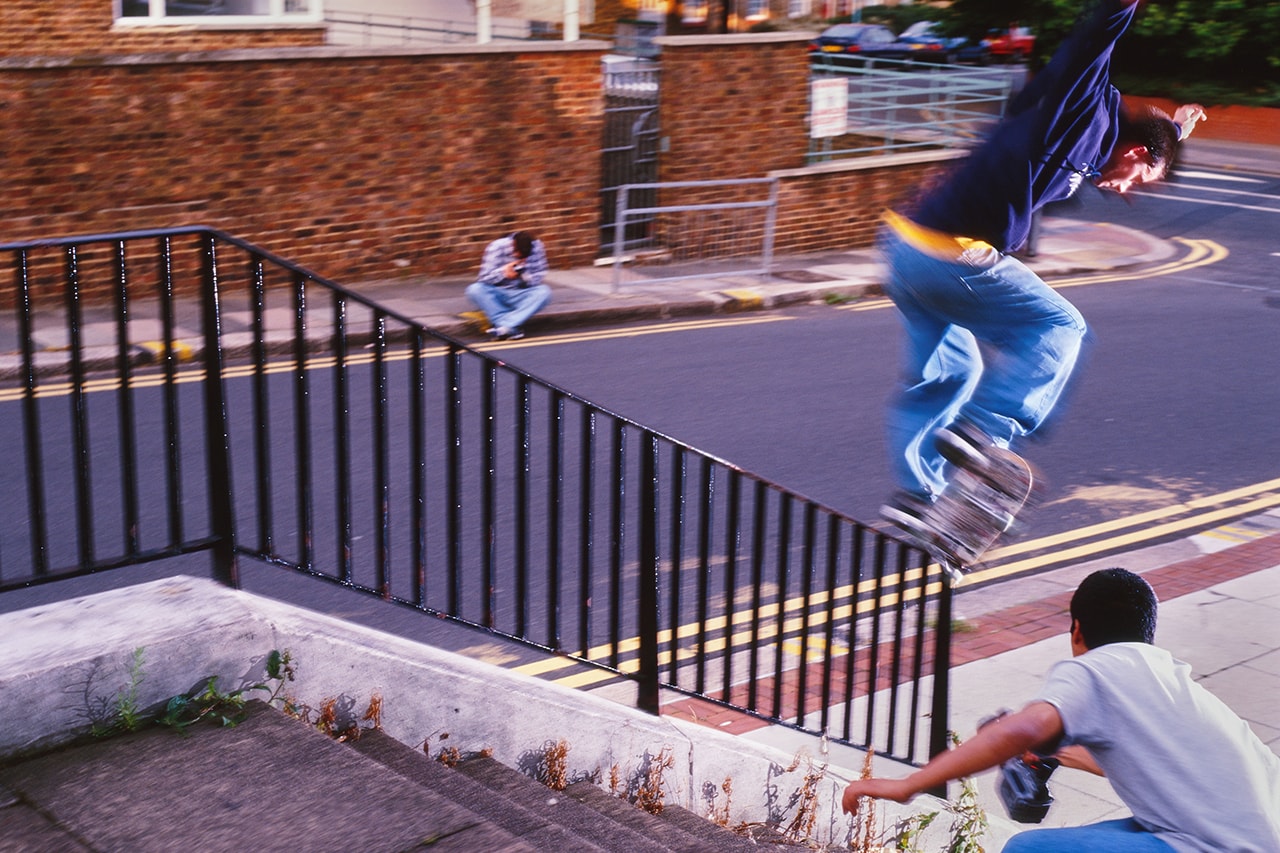
John Rattray, Crooked Grind, Brentford, 1999.Wig Worland
The Struggle for Acceptance
Whitter: The ‘90s were a difficult time for a lot of us, we weren’t accepted by anyone. In terms of skating around the city, the police were really horrible to us, the security was horrible. They’d call the police and they put down measures to stop us skating, hosing down the floor, throwing stones. They got architects to design these things, even some sell-out skaters were telling them what they could do to stop skaters getting to the ledge. It wasn’t a good time, skaters were turning against each other for money.
I remember people switching off lights at Southbank to stop us skateboarding, the security stopped us from skating there even though it was a legitimate spot.
Neil MacDonald, writer and archivist, Science Versus Life: The difference between the acceptance levels then and now are enormous. Then, people didn’t know that we weren’t vandals, people didn’t know how good skateboarding could be and how important it was. They presumed that the fun of skateboarding was to f*ck things up.
Mackey: My experiences in Liverpool in the early ‘90s, they’re not the same experiences that a kid in Liverpool would have now. We definitely weren’t accepted, we got chased out of everywhere, we got in fights, we got laughed at for the clothes we wore. We weren’t pioneers, but we were guinea pigs for what was to come after.
“We definitely weren’t accepted, we got chased out of everywhere, we got in fights, we got laughed at for the clothes we wore.”
MacDonald: Getting spat at and shouted at, wearing this stuff, learning these tricks, freezing your arse off in a soggy NCP car park on a Tuesday night, that made skateboarding what it is. The progression and the development that happened in those sessions is what made skateboarding acceptable.
Marshall Taylor, director of Slam City Skates and co-founder of Palace: You were always seen at school as the odd kid that wears brands that no one has ever heard. I remember going into school wearing Vision and the original AirWalks. You’d literally get laughed at by the older kids in their adidas or whatever. Skateboarding was so far removed from any mainstream fashion.
MacDonald: The way that we dressed didn’t help things. Wearing shell toes, [adidas] Gazelles, [Puma] Clydes, when those shoes cost £5. They were bargain bucket stuff. We had these £5 shoes on and they were full of holes, we looked ridiculous. Nowadays people want to look like skateboarders, but in those days you would get the bus to the spot and you’d be wearing your chill shoes because you wouldn’t want to wear your f*cked up skate shoes on public transport. You’d have to change when you got to the spot.
Whitter: The policing had also increased. I got into a situation at Liverpool street on a Sunday in 1997. There was no one there, but the Police had nothing else to do so they chased us down and fined us for skating on the pavement. They arrested me for rolling wheels on a pavement, a law that had been introduced in the 1800s. They applied that rule and fined me £50, which was a lot of money then.

Rich Gilligan
A British Subculture Emerges
Adams: We were all doing it. We’d been building this and making ramps and having competitions and printing zines, and then suddenly there’s this full color magazine [Read and Destroy] which was very much Tim Leighton Boyce’s project, he’d always wanted to find a way to bring skateboarding back into the mainstream view, and this is the way he could do it.
It hit a group of kids who were kind of 12 or 13, who had maybe been dabbling with a bit of BMX riding, a bit of skateboarding, just messing around. Then suddenly, there’s this magazine. People have said to us that they might have been a little kid in a provincial village or a crappy town and they would go into the newsagent and there on the shelf was this bright colored magazine that really spoke to them. It said “I am your culture, come and get me, it’s all in here.”
Worland: The magazines were one of the only ways the skateboard scene could communicate with itself. The other way was the intermittent video releases of the time, which took much longer to collate and distribute.
Starting Sidewalk [in 1995] was a lot of fun. We really felt that the UK’s skateboard talent needed to be represented properly and to the same standard that the American magazines were producing, at the very least. Read and Destroy had inspired us but we wanted to continue what they had started. We felt it was important. This was of course borne out by the likes of Tom Penny and Geoff Rowley arriving in the US from the UK. They played a huge role in the changing face of skateboarding in the 1990s and beyond.
“Skateboarding grew from that moment on. It realised what it was, and what we wanted was important. It wasn’t about corporate brands dictating what music you should listen to or what tricks you should do.”
Mackey: [The early ‘90s] were about us understanding the culture we were a part of. Skateboarders were taking a hold of it for themselves and saying: “we can get boards made, we can make videos that talk to us, because these big brands are talking to f*ck knows who. They’re not talking to us. Their musical tastes aren’t the same, their fashion choices aren’t the same, the skate spots aren’t the same.”
Taylor: Back then, it was driven totally by American brands. There was still a massive US influence in the late ‘80s and early ‘90s. From a fashion point of view at that point, everything was US driven and the whole skate/style scene, videos, tricks, riders were Californian driven.
Mackey: Skateboarding grew from that moment on. It realised what it was, and what we wanted was important. It wasn’t about corporate brands dictating what music you should listen to or what tricks you should do. We were finding these things, and we were excited by them. That’s what happened in the early ‘90s. From what I remember, it was very hazy.
Skateboarders took back skateboarding. They started creating their own smaller brands, which would become the bigger brands. It was new, fresh and exciting, I think we got a common excitement globally. We wanted to support them, be a part of everything they did, and wear the T-shirts. A lot of brands came from that period of time. Supreme obviously formed in those early ‘90 years, and the same for a lot of stores like Slam City Skates in the UK.
Taylor: It was in the ‘90s that the tide started to turn. Blueprint — a brand started by my friend who I lived with, Dan Magee — was one of the first to do that. There started to become more of a UK and European influence in skateboarding. From a style point of view, it really completely changed.

Matt Anderson and Mike Manzoori, Frontside Over The Bollocks, Harrow Skatepark, 1995.Wig Worland
Mackey: It was around 1996 to 1999 when skateboarders started opening their own stores. There was this newfound business that skateboarders could be involved in that involved skateboarding but you didn’t have to be a professional skateboarder or attached to a brand to make it. You could open a shop and sell product.
This was a new side of skateboarding in the UK, and it really allowed for the next chapter which was big British board brands, and skateboarders not having to move to the US to make it. We suddenly had home grown brands that supported us here, so we could all be part of this bigger skateboarding industry.
Taylor: It got to that point where you could start your own small little T-shirt brand or clothing brand or start to get your own boards pressed. Everything was super organic, there weren’t large volumes of money to start the business. There was money here and there and you’d maybe go down to Southbank and sell some of the boards.
Another good thing about skateboarders at that stage was that everyone was flying over to the States. My friends were going to spend a week or six weeks in San Francisco or LA from a really early age. Suddenly, you bump into people there and they ask what you’re riding or look at what you’re wearing. That was how European brands started to get known in some of the US big cities, because skateboarders are so transient and they’re always travelling to find spots. There’s a really big community feel. That’s how, before social media, brands would build.
Mackey: I came back to the UK from New York, and I was made redundant from my job in a factory. We all had regular jobs, skateboarding wasn’t a job for most of us. At that moment in time, there was no store in Liverpool and I saw other skate shops that were run and operated by skateboarders for skateboarders gave me the spark to do a similar thing for Liverpool.
Taylor: A lot of American brands initially were trying to put the brakes on European companies, trying to stop them, trying to stop the wood factories producing boards. Suddenly, where there had been no threat, they could start to lose a small amount of market share and hype and interest.
Check out Part Two of our Oral History of U.K. Skateboarding here.
